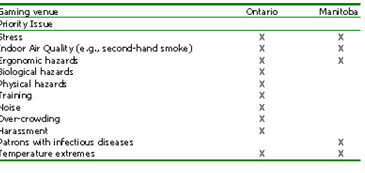Very few scientific studies report on gaming workers’ health and safety. The few studies that do (e.g., Shaffer, Vander Bilt & Hall, 1999; Lapenz & Lester, 1997; Trout & Decker, 1996; Darcy & Lester, 1995) might not fully explore the potential health and safety risks gaming workers face (Keith et al., 2001). Research conducted by Keith et al. (2001) explores some of these risks via participatory action research.
Keith et al. (2001) recruited a total of seventy-one gaming workers from two Ontario (n=51) and three Manitoba (n=20) gaming facilities. Sixteen occupational groups were represented: dealers (n= 17) and cleaners/porters (n=13) were most heavily represented. Health and safety issues were assessed via mapping methodology. Specifically, the investigators employed body mapping, hazard mapping, and "Your World" mapping strategies. Body mapping elicits data on gaming workers’ health (e.g., illness and injury) problems, asking participants to mark a large body image with self-sticking dots. Hazard mapping pulls data from work area diagrams drawn by workers to illustrate any existing biological, physical, stress, or work design hazards. "Your World" mapping asks gaming workers to add words or symbols to a human figure drawn in the center of a large piece of paper to represent areas of their life they believe to be affected by their work (Keith et al., 2000). Upon completion of each mapping exercise, the investigators identified priority problems.
The results of body mapping indicate that gaming workers suffer from lower back, shoulder, joint, neck, and head pains (Keith et al., 2001). Such discomforts are the result of repetitive strain injuries. General health problems include respiratory track, reproductive, and eye problems attributed to second-hand smoke, poor ergonomic design, and flashing lights respectively.
Hazard mapping data shows that physical, chemical, biological, work design, and stress hazards confront gaming workers (Keith et al., 2001). Physical hazards include poor temperature control and noise. The most often cited chemical hazard is tobacco smoke. Biological hazards are those associated with the handling of money and game chips that might spread germs and disease. Casino workers consider poor ergonomics, long-term standing, and crowded spaces as work design hazards. Stress hazards include customer relations and personal safety to and from the job.
Finally, "Your World" mapping points to the impact pain, fatigue, and schedule disruptions have upon gaming workers. Relationships with family and friends reportedly suffer, as do childcare responsibilities. Marital separation and divorce also are reported. Table 1 illustrates the workplace issues gaming workers from both venues consider most important to solve.
Empirical research validates the mapping methodology (Mujica, 1992) and confirms data collected from drawings by Italian factory workers depicting workplace hazards (Keith et al., 2001). However, the scientific precision of mapping methodology remains uncertain. Mapping methodology is based entirely on self-report and, consequently, cannot scientifically or medically confirm whether all of the health problems reported by employees are indeed accurate. In addition, it is not possible to determine if these problems are the result of the gaming environment. Perhaps some gaming workers suffer from preexisting health conditions that have never been properly diagnosed. Others might suffer from health problems that originate outside the gaming workplace that are aggravated by their employment responsibilities. A thorough medical examination and review of each research participant’s medical history and lifestyle, as well as comparative analyses of priority issue selection among different gaming venues, might serve to validate scientifically the data collected via mapping methodology.
Nevertheless, Keith et al. (2001) have contributed to an otherwise under-studied area of gambling research. An understanding of the health effects gaming venues have on employees is vital for the physical and emotional well being of those who work in the gaming industry as well as those served by these workers.
References
Darcy, P., & Lester, D. (1995). Job satisfaction in casino dealers. Psychological Reports, 77, 642.
Keith, M. M., Cann, B., Brophy, J. T., Hellyer, D., Day, M., Egan, S., Mayville, K., & Watterson, A. (2001). Identifying and prioritizing gaming workers’ health and safety concerns using mapping for data collection. American Journal of Industrial Medicine, 39, 42-51.
Lapenz, S. K., & Lester, D. (1997). Job satisfaction in casino employees. Perceptual and Motor Skills, 84, 1258.
Mujica, J. (1992). Coloring the hazards: risk maps research and education to fight health hazards. American Journal of Industrial Medicine, 22, 767-770.
Shaffer, H. J., Vander Bilt, J., & Hall, M. N. (1999). Gambling, drinking, smoking and other health risk activities among casino employees. American Journal of Industrial Medicine, 36(3), 365-378.
Trout, D., & Decker, J. (1996). Health Hazard Evaluation Report No. HETA-95-0375-2590, Bally’s Park Place Casino Hotel, Atlantic City New Jersey. Cincinnati: Hazard Evaluations and Technical Assistance Branch, NIOSH, U.S. Department of Health and Human Services.
The WAGER is a public education project of the Division on Addictions at Harvard Medical
School. It is funded, in part, by the National Center for Responsible Gaming, the
Massachusetts Department of Public Health, the Addiction Technology Transfer Center of
New England, the Substance Abuse and Mental Health Services Administration, and the
Center for Substance Abuse Treatment.





